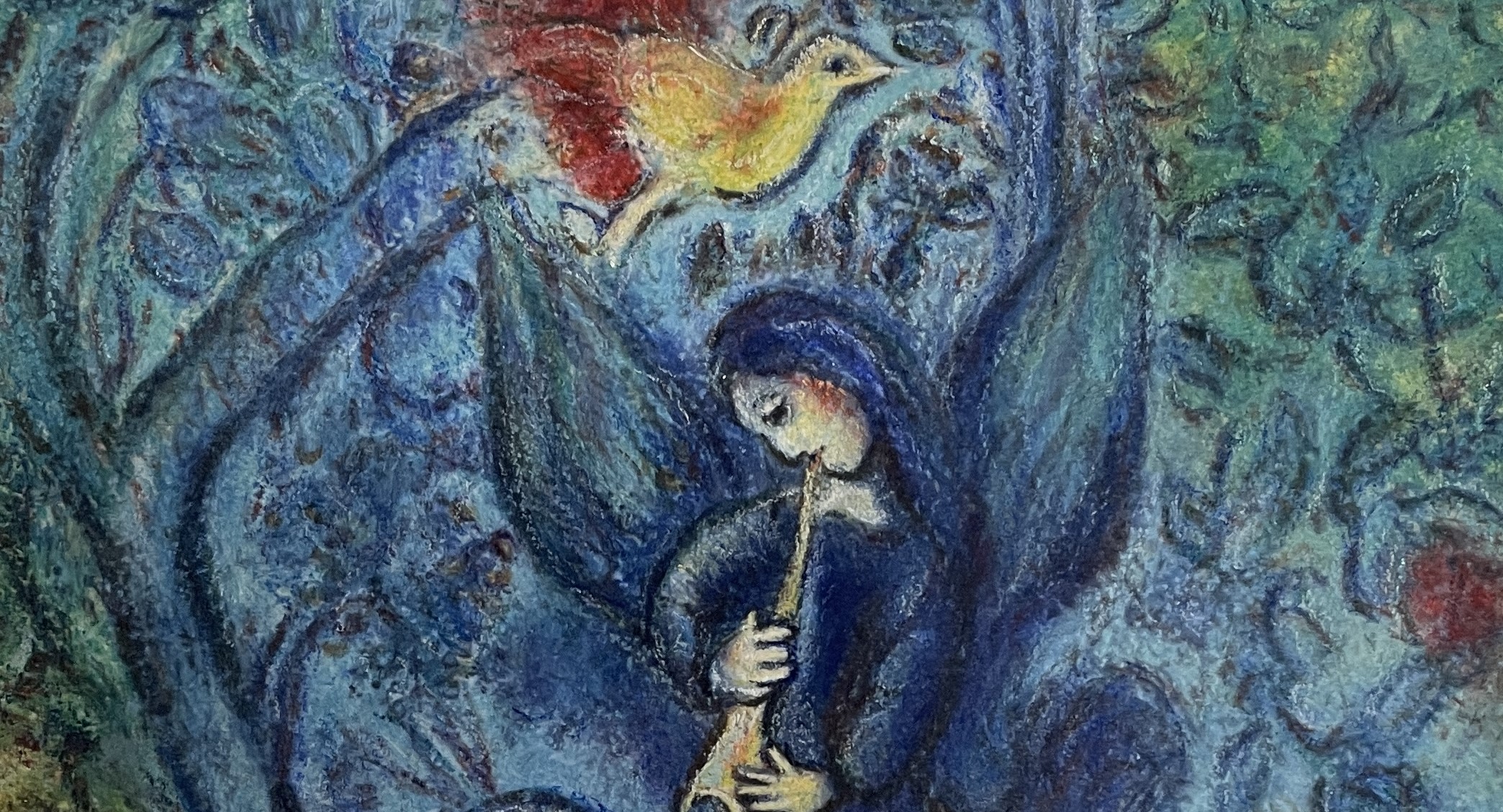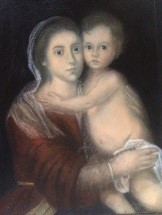日本語-Englishー台灣華語
バルトロメ・エステバン・ムリーリョ「ロザリオの聖母子」
「ロザリオの聖母」はスペインのプラド美術館にある。プラド美術館には3つの門がある。正面のベラスケスの門、北側のゴヤの門、そして南国セビリア生まれのムリーリョの門。ムリーリョは古都セビリアに孤児として生まれ、セビリアで生涯を閉じた。王侯貴族のためではなく、自分を育ててくれた教会のために一生を捧げて絵を描いた。ムリーリョの絵は日本ではめったに観ることができないが、どこか温か味があり、今見てもとても身近に感じる。ムリーリョの絵を見ているとコローの人物画を思い出す。底抜けに心優しき人間であったに違いない。
この「ロザリオの聖母」はムリーリョの数ある聖母子の中でも、最も至福に満ちた作品の一つである。乙女のようなマリアに抱かれた幼児キリストはロザリオ(念珠)によって結ばれている。母と子はぴたりと頬を寄せ、深い愛情を感じさせる。この絵の聖母は若すぎるが、聖母マリアと幼児キリストの顔立ちは血の繋がりを感じさせ、聖母子の一体感を高めている。
ムリーリョは、ベラスケスが栄光あるスペインリアリズム絵画の頂点を極めた後に続く、スペインバロック期を代表する画家である。ラファエロの甘美さを更に身近にしたような聖母像は、民衆の圧倒的人気を得た。ムリーリョが活躍した十七世紀のスペインは苦難の時代であった。スペインの無敵艦隊は英国に敗れ、国力は急速に傾いていた。ペストの猛威に襲われ、ムリーリョの住んでいたセビリアでは、人口が半減したと伝えられている。ムリーリョ自身も、最愛の妻や子供達の大半を失っている。飢えと疫病が巷に溢れ、人々は困窮した生活に絶望していた。落日のセビリアで人々は救いを求めていた。それに答えた画家がムリーリョだったのである。
ムリーリョは可憐な「無原罪の御宿り」の画家としてあまりにも有名となり、繰り返される同じような絵に画家としての評価を低く見る向きもあるが、質素な日常の生活のなかに信仰を描いた子供たちの絵は、限りなく愛らしい。生き生きとした表情が、煙るようなやさしい筆さばきと落ち着いた色彩で描かれ、その画面には深い信仰心が溢れている。貧しくとも無邪気に遊ぶ子供たちの姿には、ムリーリョ自身の生い立ちや亡き子供たちの姿が投影されているに違いない。生涯を通じて感じたであろうムリーリョの信仰の拠り所、それは日常のささやかな仕合わせである。セビリアの街には信仰が溢れている。
実際に行って見ると、ムリーリョはあちらこちらに面影を残し、今もセビリアの人たちに愛されているのをひしひしと感じる。芸術家の評価とは何だろうか。時代を超えて人々に生きる勇気を与え続ける芸術こそ、ある意味真の芸術の使命を果たしているのではないだろうか。温かな情愛に触れるとき、人は生きる勇気を与えられる。ムリーリョの絵はそれを語り続ける。
Virgin with a Rosary
“The Virgin of the Rosary” is in the Prado Museum in Spain. The Prado Museum has three gates: the Velázquez Gate at the front, the Goya Gate on the north side, and the Murillo Gate, named after the artist, born in the southern city of Seville. Murillo was born an orphan in the ancient city of Seville and spent his entire life there, dedicating his life to painting not for the nobility, but for the church that raised him. Murillo’s paintings, rarely seen in Japan, possess a warmth that feels very familiar even today. Viewing Murillo’s work often brings to mind the figure paintings of Corot, suggesting that Murillo must have been an exceedingly kind-hearted person.
Among the numerous Madonna and Child works by Murillo, “The Virgin of the Rosary” stands out as one of the most blissful. The infant Christ, cradled by a maiden-like Mary, is bound with a rosary. The mother and child press their cheeks together, conveying deep affection. The youthful depiction of the Virgin in this painting may seem too young, but the facial features of the Virgin Mary and the infant Christ suggest a blood relationship, enhancing the sense of unity between mother and child. Following Velázquez, who reached the pinnacle of glorious Spanish realism, Murillo became a leading painter of the Spanish Baroque period. His depiction of the Virgin, bringing Raphael’s sweetness closer to the common people, won overwhelming popularity. The 17th century, when Murillo was active, was a difficult time for Spain. The Spanish Armada was defeated by England, and the nation’s power rapidly declined. Plague ravaged the country, and it is reported that the population of Seville, where Murillo lived, was halved. Murillo himself lost his beloved wife and most of his children. With famine and disease rampant, people lived in despair. In the declining days of Seville, people sought salvation, and Murillo was the artist who answered that call.
Murillo, famous for his exquisite paintings of the Immaculate Conception, faced criticism for his repetitive themes, which some believed diminished his standing as an artist. However, his paintings of children, depicting faith within the simplicity of everyday life, are endlessly charming. Their lively expressions are captured with a gentle, smoky brushwork and calm colors, overflowing with deep faith. The images of children playing innocently, despite their poverty, undoubtedly reflect Murillo’s own upbringing and the images of his deceased children. The faith that Murillo must have felt throughout his life was rooted in the modest happiness of everyday life. Faith overflows in the streets of Seville. In fact, visiting Seville, one can strongly feel Murillo’s presence still cherished by the people there. What is the evaluation of an artist? Art that continues to give people the courage to live across ages might, in a sense, fulfill the true mission of art. When touched by warm affection, people are given the courage to live. Murillo’s paintings continue to tell this story.
巴爾托洛梅·埃斯特萬·莫里略「玫瑰聖母」
「玫瑰聖母」位於西班牙的普拉多博物館。普拉多博物館有三個入口,正面是貝拉斯凱茲之門,北側是戈雅之門,而來自南方塞維利亞的莫里略之門。莫里略生為塞維利亞的孤兒,終其一生都在塞維利亞度過。他不是為了王公貴族而畫畫,而是獻給了撫養他的教會。莫里略的畫作在日本很少見,但卻有一種溫暖,即使是現在看也感覺非常親近。看莫里略的畫會讓人想起柯洛的人物畫。他一定是一個無比善良的人。
這幅「玫瑰聖母」是莫里略眾多聖母與聖子畫作中,最充滿至福感的一幅。如同少女一般的瑪麗亞懷中抱著的嬰兒基督被玫瑰念珠連結在一起。母與子緊貼著面頰,流露出深深的愛意。這幅畫中的聖母看起來過於年輕,但聖母瑪麗亞和嬰兒基督的臉龐彼此相似,增強了聖母子之間的統一感。莫里略是繼貝拉斯凱茲之後,西班牙巴洛克時期的代表畫家。他的聖母像讓拉斐爾的甜美感更加貼近民眾,獲得了壓倒性的人氣。莫里略活躍的十七世紀是西班牙的苦難時代。西班牙的無敵艦隊被英國擊敗,國力迅速衰落。塞維利亞遭受瘟疫的肆虐,據說人口減少了一半。莫里略本人也失去了愛妻和大部分的孩子。飢餓和疫病充斥街頭,人們絕望於貧困的生活。在夕陽下的塞維利亞,人們尋求救贖。回應他們的正是莫里略。
莫里略以其「無原罪懷孕」的畫作聞名遐邇,一些人因為他重復相似的主題而對他的評價不高,但他描繪信仰於質樸日常生活中的孩子們的畫作,卻是無比可愛。生動的表情透過煙霧般柔和的筆觸和平和的色彩被描繪出來,畫面充滿了深厚的信仰感。貧窮但無邪地玩耍的孩子們的形象無疑反映了莫里略自己的成長經歷和逝去的孩子們的形象。莫里略一生感受到的信仰寄託,那就是日常生活中的小小幸福。塞維利亞的街道上充滿了信仰。實際上去看,可以強烈感受到莫里略留下的痕跡,他至今仍深受塞維利亞人民的愛戴。什麼是藝術家的評價呢?跨越時代持續給予人們生活勇氣的藝術,或許正是真正的藝術使命。當接觸到溫暖的情感時,人們獲得了生活的勇氣。莫里略的畫作就是持續訴說這一點。


